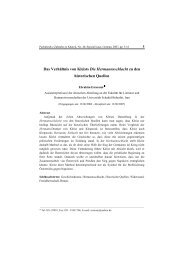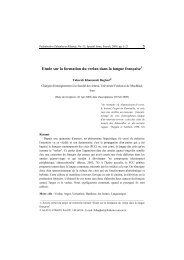Phonological Metathesis in Persian: Synchronic, Diachronic, and the ...
Phonological Metathesis in Persian: Synchronic, Diachronic, and the ...
Phonological Metathesis in Persian: Synchronic, Diachronic, and the ...
Create successful ePaper yourself
Turn your PDF publications into a flip-book with our unique Google optimized e-Paper software.
6 Pazhuhesh-e Zabanha-ye Khareji, No. 56, Spr<strong>in</strong>g 2010<br />
1. Introduction<br />
One of <strong>the</strong> long st<strong>and</strong><strong>in</strong>g issues <strong>in</strong> l<strong>in</strong>guistic <strong>the</strong>ory is meta<strong>the</strong>sis. <strong>Meta<strong>the</strong>sis</strong> can<br />
be def<strong>in</strong>ed as <strong>the</strong> process where by <strong>in</strong> certa<strong>in</strong> languages, under certa<strong>in</strong> conditions<br />
sounds appear to switch positions with one ano<strong>the</strong>r. Thus <strong>in</strong> a str<strong>in</strong>g of sounds where<br />
we would expect <strong>the</strong> l<strong>in</strong>ear order<strong>in</strong>g of two sounds to be …xy…, we f<strong>in</strong>d<br />
<strong>in</strong>stead…yx…..<br />
The explanation to <strong>the</strong> meta<strong>the</strong>sis has been to say that this process is <strong>in</strong>deed less<br />
natural phonetically than o<strong>the</strong>r processes, <strong>and</strong> has a relatively greater phonological<br />
motivation. First suggested by neogrammarian movement (Osthoff & Brugman<br />
1878: xvi), this view was clearly stated by Brugmann (1902:246): "<strong>Meta<strong>the</strong>sis</strong> arises<br />
when <strong>the</strong> order of sounds <strong>and</strong> <strong>the</strong> syllable boundary make <strong>in</strong>convenience; it causes a<br />
group of sounds to be placed where it is easier for <strong>the</strong> speaker". This phonetic<br />
optimization approach has prevailed <strong>in</strong> descriptive <strong>and</strong> typological studies.<br />
Accord<strong>in</strong>g to Grammont (1950:239), for <strong>in</strong>stance, meta<strong>the</strong>sis yields a better syllable<br />
structure safeguards unity <strong>and</strong> harmony of languages sound system <strong>in</strong> replac<strong>in</strong>g<br />
unusual groups by common groups which are or have become unpronounceable <strong>in</strong><br />
substitut<strong>in</strong>g simple types for <strong>the</strong>m <strong>and</strong> avoids useless articulatory effects. Ultan's<br />
(1985:395) survey also concludes that <strong>the</strong> superficial cause of most meta<strong>the</strong>ses is<br />
conversion of a phonologically <strong>in</strong>admissible or disfavored sequence <strong>in</strong>to an<br />
acceptable one. F<strong>in</strong>ally, Hock (1985:532-33) contends that meta<strong>the</strong>sis can become<br />
regular only when it serves a specific structural purpose usually that of convert<strong>in</strong>g<br />
phonologically or perceptually marked structures <strong>in</strong>to more acceptable ones.<br />
2. The Nature of meta<strong>the</strong>sis<br />
<strong>Meta<strong>the</strong>sis</strong> has resisted a unified, explanatory treatment <strong>in</strong> nonl<strong>in</strong>ear phonology<br />
despite advancements <strong>in</strong> <strong>the</strong> formalism used to account for many o<strong>the</strong>r processes,<br />
such as assimilation (Clements, 1985) <strong>and</strong> dissimilation (Odden 1987). Unlike <strong>the</strong>se<br />
phenomena, <strong>the</strong>re is no unique formalism for characteriz<strong>in</strong>g meta<strong>the</strong>sis as a<br />
primitive rule type. Instead meta<strong>the</strong>sis effects have been derived by a variety of<br />
different means <strong>in</strong>clud<strong>in</strong>g: successive application of rules of deletion <strong>and</strong> <strong>in</strong>sertion






